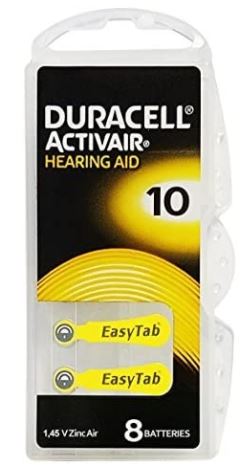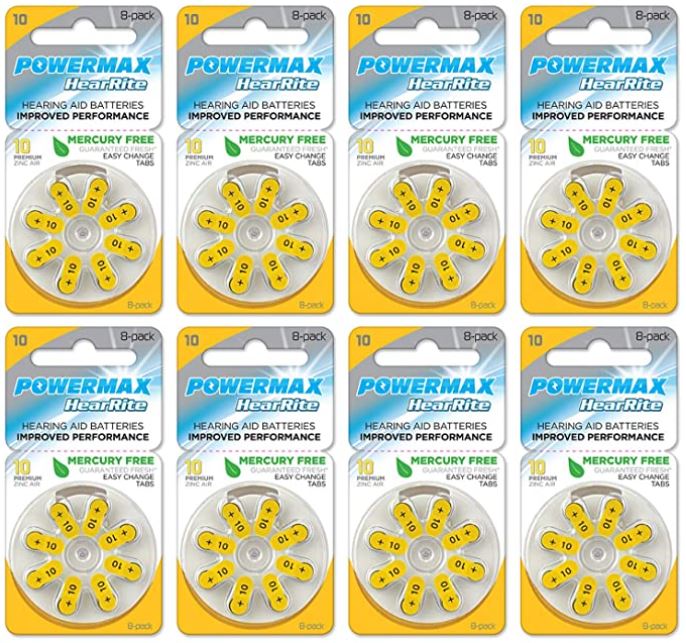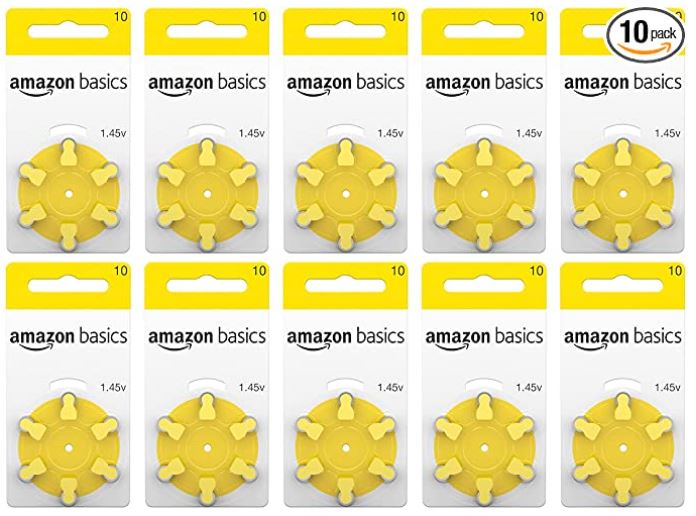If you’ve been around long enough, you probably remember old-fashioned hearing aids. Not long ago, your hearing aid wasn’t something you just popped into your ear. Instead, you had a big blocky device in your pocket, with earbuds and wires connected. These older hearing aids usually used AA batteries, and were inconvenient to use. As technology got smaller, these big batteries were replaced by watch-style batteries. Modern hearing aids use an array of little tiny button-style cells for power. And because they’re more advanced, these batteries last as long as the AAs in old-school hearing aids.
That said, you don’t want to use just any old hearing aid battery. The last thing you want is to get caught out in public with a dead battery. Not only that, but the cost of batteries adds up over time. Sure, a single battery costs less than a dollar. But when you’re going through them day after day, that can turn into a considerable cost. You want a battery that’s effective, reliable, and long-lasting. You also want packaging that’s easy to transport. Since you’ll inevitably need to change your batteries on the go, it’s important that they’re convenient to carry. So far from being an insignificant choice, finding the best hearing aid battery can be a huge benefit.
We’re about to review three of the top hearing aid batteries available in the four most common sizes. We’ll start with the Duracell Activair. This is your favorite copper-top brand, with all four major sizes available. Next, we’ll take a look at the Powermax hearing aid batteries. This is a more affordable brand, which offers all sizes except 675. Last but not least, we’ll consider the Amazon Basics hearing aid batteries. This is a readily-available alternative that ships in all sizes. But which brand is going to be the optimal choice for your needs? To answer that question, we’ll need to dig deeper, and take a look at their various features. Then, we’ll be able to make a fair comparison. Let’s get started!
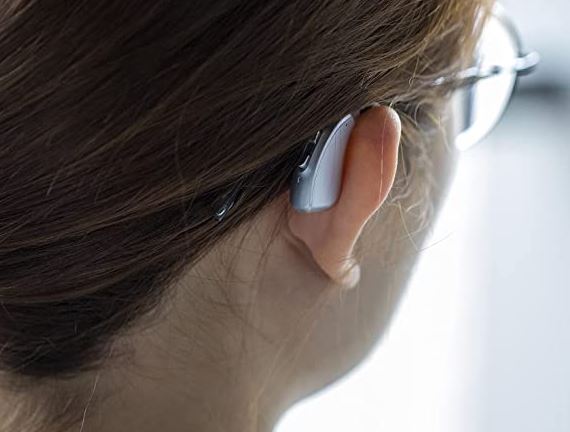
What Size Battery Do I Need?
Before we talk about any particular batteries, let’s start with the basics. What are the different hearing aid battery sizes, and which size do you need? For the most part, hearing aid batteries come in four sizes. From smallest to largest, these are Size 10 (sometimes called 230), Size 312, Size 13, and Size 675. The exact quality of the battery depends on the manufacturer. That said, larger batteries have more power and capacity. As a result, you might expect them to last longer than smaller batteries, but that’s not always the case. Hearing aids that require larger batteries typically draw more power. As a result, your battery life will depend on the battery quality, your hearing aid, and your volume.
All four standard hearing aid battery sizes are very small, with less diameter than a dime. By international standard, they’re not just standardized by size. The pull tabs on the backs also come in standardized colors. As a result, the tab color is the easiest way to tell what size battery you need. If you’re fresh out of new batteries and don’t have a tab to compare, don’t fret. The battery size will be stamped somewhere on the battery itself. The numbers can be very small, though, so you’ll need to put on your reading glasses. Here are the details of the four battery sizes:
- Size 10 (or 230) batteries are the smallest type, and come with a yellow tab. They have a diameter of 5.8mm, and a thickness of 3.6mm. They’re most commonly used for In the Canal (ITC) and Completely in Canal (CIC) devices.
- Size 312 batteries are the next size up, and they come with a brown tab. They have a diameter of 7.9mm, with the same 3.6mm thickness as the Size 10. They’re most commonly used for ITC and In the Ear (ITE) hearing aids.
- Size 13 batteries are the second-largest size, and come packaged with an orange tab. They have the same 7.9mm diameter as the Size 312, but with a beefier thickness of 5.4mm. As a result, it can easy to get the two size confused, so make sure you’re careful with these sizes. The Size 13 is most commonly used in ITE and Behind the Ear (BTE) hearing aids.
- Size 675 batteries are the largest size of all, and ship with a blue tab. Like the Size 13, they’re 5.4mm thick, but they have a much larger diameter, at 11.6mm. These are typically used in BTE hearing aids with more complex circuitry. That said, these batteries are bulkier and heavier than the other varieties.
Keep in mind that these are only the four most common sizes. While almost all modern hearing aids will use one of the four, that’s not always going to be the case. There are some hearing aids that take other sizes of watch-type battery. For example, there’s the Size 5 battery, which comes with a red tab. But those are only used in a tiny percentage of hearing aids.
No matter what size battery you need, it’s important to keep your hearing aids clean and dry. If you don’t already have cleaner, check out our list of the best hearing aid cleaners and dryers. Sooner or later, you’ll be glad you did.

What’s the Best Type of Hearing Aid Battery?
When it comes to hearing aid batteries, there’s only one acceptable choice, and that’s zinc-air. All of the batteries we’ve listed today use zinc-air technology. Zinc-air batteries have a major advantage over other technologies, because the surrounding air actually becomes part of the battery. This reduces the amount of material required to make a battery, so they can be smaller and lighter. So, how does this work?
The back of the battery is actually made out of a specialized, high-tech material. While it looks like bare metal, it’s actually a waterproof membrane that allows gas to penetrate. This facilitates oxygen passing from the air into the battery. As oxygen enters, it reacts with the internal zinc material to produce electricity. As the zinc is used up, the weight of the battery slowly decreases. Because of the way they’re designed, these batteries are not rechargeable. You’d have to open them up and replace the zinc anode itself. At that point, simply buying a new battery is a better alternative.
One major advantage of zinc-air batteries is that they have an incredibly long shelf life. As long as the tab is left in place, the membrane is covered, and no air can penetrate. In this state, a zinc-air battery will only lose about 2 percent of its capacity per year. That said, the opposite is also true. Once the tab is removed and air can penetrate, the chemicals inside will immediately start to dry out. This starts to happen within five seconds of removing the tab. Once the tab is removed, you need to start using the battery immediately. Otherwise, it will drain itself fairly quickly.
Another advantage of zinc-air technology is that it has a very high energy density. Compared to the density from lead-acid or Lithium-ion batteries, you’re getting way more bang for your buck. Once again, though, the opposite is also true. While there’s a lot of energy density, zinc-air batteries can’t deliver a lot of power all at once. If you wanted to use one for industrial applications, it would have to be enormous. That’s why zinc-air batteries are almost exclusively used for low-voltage applications, like hearing aids. The only exception is when extreme levels of reliability are needed. In that case, you will indeed see huge zinc-air batteries at railway safety lamps and other key infrastructure. But with those few exceptions, the only time you’ll see this technology is in a hearing aid or watch battery.
Duracell Activair
If you’re looking for a reliable battery brand, it’s tough to do better than Duracell. Along with Energizer, they’re one of the two premier brands on today’s market. As a result, they make a good choice. This is especially if you’re willing to pay a bit more to get the best quality.
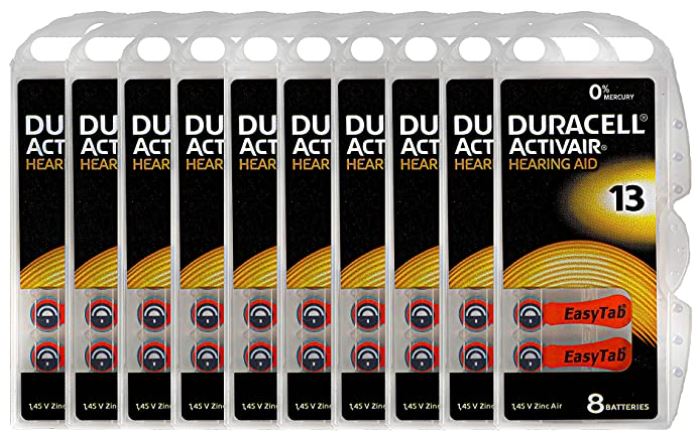
One thing we liked about these batteries was the secure packaging. Normally, we don’t get too excited about packaging, but this is one of the rare exceptions. With a lot of hearing aid batteries, the packaging is a bit of a problem. You open a multi-pack, take two batteries out, and then you have to be careful not to lose all the others. The Duracell batteries, on the other hand, come in a convenient plastic package with a locking tab. Even after you’ve taken out some batteries, the others will remain secure. You can carry the package around in your pocket or purse without worrying about losing your batteries.
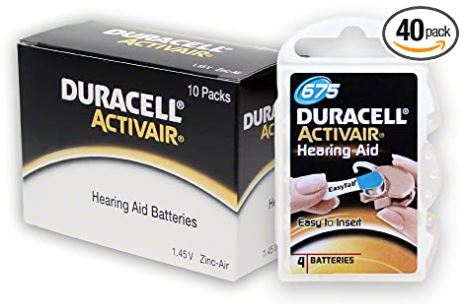
The Duracell hearing aid batteries come in all four common sizes. The size 10 batteries come in an 80-pack, with 10 packages of 8 batteries apiece. All the plastic cases come in a single cardboard box, which makes them easy to store. The design of the cases also makes the batteries easy to remove, with the tabs easily accessible. The other sizes come in different quantities, but the general principle is the same. The size 312 batteries come in a 60-pack, with 10 cases of 6 batteries each. The size 13 batteries come in an 80-pack, with 10 8-battery cases. The size 675 batteries come in the lowest quantity, with 10 cases of 4 for a total of 40 per pack.
Powermax
The Powermax hearing aid batteries, like the Duracell batteries, come in a large box with multiple cases. However, the cases are flat cardboard cards, with plastic bubbles arrayed in a circle on the front. You pop open a tab on the back, and remove the batteries through the hole. To access more batteries, simply rotate the circle of plastic bubbles to align them with the hole.
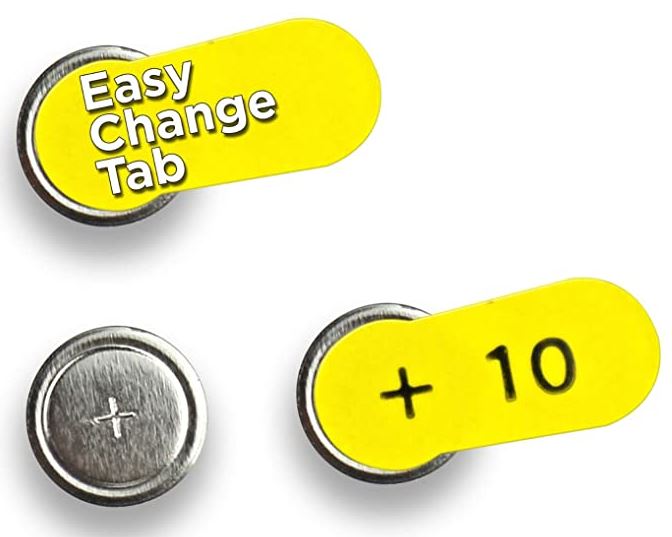
Each dispenser has eight batteries inside, no matter what size. You can order boxes of 64, 128, or 192, in sizes 10, 312, and 13. The large, S675 batteries are not available. These batteries aren’t quite as long-lasting or reliable as the Duracells. But out of our three options, they offer the best pricing.
Amazon Basics
Amazon Basics is well-known for making all kinds of everyday gear, including rechargeable AA and AAA batteries. The Amazon Basics hearing aid batteries ship in a similar package to the Powermax. The only major difference is that there are 6 batteries per dispenser and 10 batteries per case. In other words, all sizes come in a 60-pack. This includes size 10, 312, 13, and 675. These batteries are nearly as reliable as the Duracells, with a rated shelf life of four years. Then again, they cost more than the Duracell batteries, and you don’t get the convenient plastic package.
Final Verdict
The difference between these three batteries comes down to three things: quality, price, and packaging. On the first and last criteria, the Duracell Activair batteries come out on top. These are high-quality Duracell batteries that work very reliably. They also come in convenient packaging that makes it hard to lose your batteries.
The Powermax hearing aid batteries, on the other hand, are the easiest on your budget. With a low per-unit cost, they still provide plenty of power to meet your needs. And while the packaging isn’t perfect, the rotating plastic bubbles provide some measure of security.
The Amazon Basics batteries are powerful enough, but they don’t win out in any one category. They’re fairly reliable, but they don’t quite reach Duracell levels of quality. The packaging is just fine, but it’s comparable to the Powermax packaging, which is much cheaper. In fact, the Amazon Basics batteries are the priciest of the bunch. Considering that fact, we’d go with one of the other two. Duracell if you want the best quality, or Powermax if you want the best value.
Meet Ry, “TechGuru,” a 36-year-old technology enthusiast with a deep passion for tech innovations. With extensive experience, he specializes in gaming hardware and software, and has expertise in gadgets, custom PCs, and audio.
Besides writing about tech and reviewing new products, he enjoys traveling, hiking, and photography. Committed to keeping up with the latest industry trends, he aims to guide readers in making informed tech decisions.


